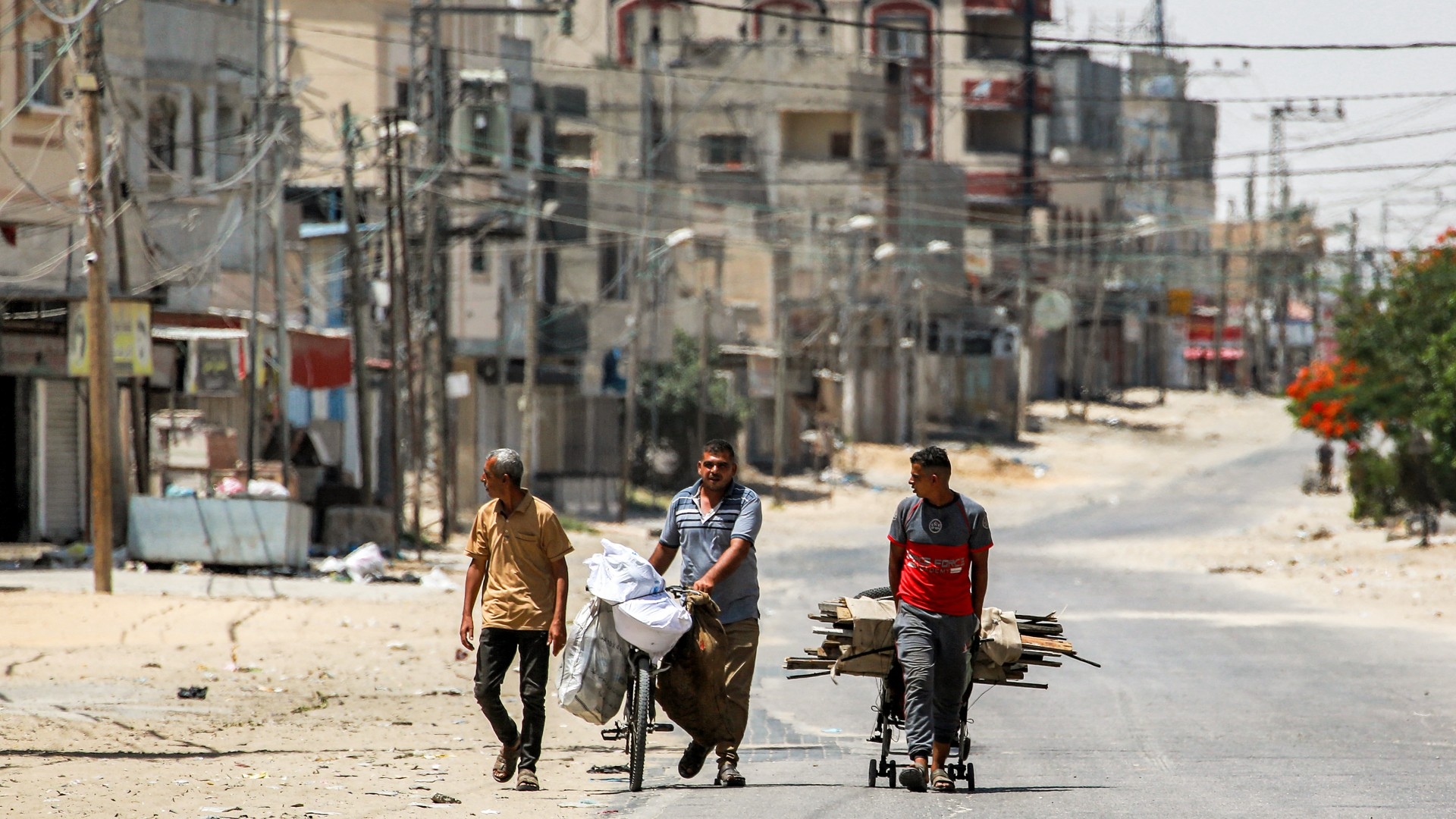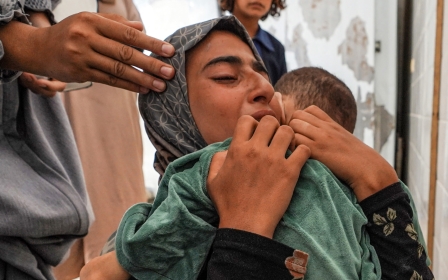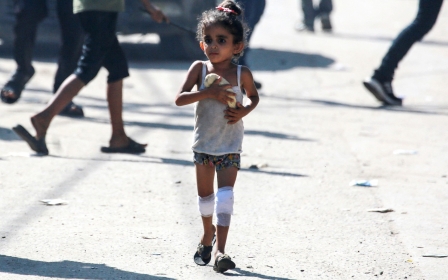Full text of Hamas reply to Israel's Gaza ceasefire proposal

Middle East Eye has obtained a copy of Hamas' response to a ceasefire proposal made by Israel, in which the Palestinian group calls for an end to the blockade on Gaza.
According to amendments submitted to Egyptian and Qatari mediators earlier this week, Hamas demanded an end to the debilitating 17-year-long siege on Gaza which would allow the free movement of people and goods into the territory.
According to other amendments, Hamas demanded that Israeli forces fully withdraw from the entire Gaza Strip in the first phase of the ceasefire, including the Rafah crossing and the so-called Philadelphi Corridor, which runs along the border between the strip and Egypt.
In addition, Hamas demanded that Russia, China and Turkey also act as guarantors that Israel would stop the fighting. The initial proposal backed by Israel and the US listed Egypt, Qatar and the US as guarantors.
US Secretary of State Antony Blinken had said on Wednesday that the Palestinian group had made numerous amendments to the US-backed ceasefire plan, some of which he deemed unworkable.
New MEE newsletter: Jerusalem Dispatch
Sign up to get the latest insights and analysis on Israel-Palestine, alongside Turkey Unpacked and other MEE newsletters
The three-phase plan had envisioned a full Israeli withdrawal only after an initial six-week truce during which the pullout was to be negotiated.
The key point of contention for Hamas was that the second phase and a transition to a permanent ceasefire be guaranteed, something which Israel has refused to accept.
Here is the full text of the reply by Hamas:
General Principles for an agreement between the Israeli side and the Palestinian side in Gaza on the exchange of detainees and prisoners and restoring a sustainable calm
The Palestinian response to the Israeli response to the 6 May 2024 proposal:
This framework’s purpose is the release of all civilian and military Israeli detainees in the Gaza Strip whether living or not regardless of the date and duration of detention, in exchange for a number that will be agreed upon of prisoners in Israeli jails, and restoring a sustainable calm which would achieve a permanent ceasefire, the withdrawal of Israeli forces from the Gaza Strip, the reconstruction of Gaza and lifting of the siege, including the opening of all border crossings, and facilitating movement of people and transfer goods without restrictions.
The framework agreement is made of three stages which are interconnected, subject to the following:
The First stage (42 days):
1. Temporary cessation of military operations by both parties and the withdrawal of Israeli forces eastwards away from densely populated areas along the borders in all areas of the Gaza Strip including the Philadelphi Corridor and Gaza valley (Netzarim axis and Kuwait roundabout) as specified below.
2. Temporary cessation of all aviation (military and surveillance) in the Gaza Strip for 10 hours daily, and for 12 hours daily on days in which detainees and prisoners are exchanged.
3. Return of the internally displaced to their places of residence and the withdrawal from the Philadelphi Corridor Gaza valley (Netzarim axis and Kuwait roundabout):
a. On day 3 (after the release of three [Israeli] detainees), Israeli forces will completely withdraw from the Rafah crossing, the whole of the Philadelphi Corridor, and al-Rasheed Road eastwards to Salah al-Din Road, and all military sites and installations in the area shall be dismantled. This withdrawal shall be completed before day 7. And the commencement of return of internally displaced people to their places of residence (without carrying arms while returning), the freedom of movement of the population in all areas of the Gaza Strip, and the entry of humanitarian aid through al-Rasheed Road from day 1 without restrictions.
b. On day 22, Israeli forces will withdraw from the central Gaza Strip (especially Netzarim axis and Kuwait roundabout axis) eastwards of Salah al-Din Road to an area along the border, and all military sites and installations in the area shall be dismantled. Return of internally displaced people to their places of residence shall continue (without carrying arms while returning), especially from southern to northern Gaza Strip, and the freedom of movement of the population in all areas of the Gaza Strip shall be guaranteed.
c. Starting from day 1, the entry of increased and adequate humanitarian aid and relief and fuel (600 trucks daily to include 50 trucks of fuel, 300 of which to the north), including fuel necessary for the operation of the power plant, trade and civilian equipment necessary to remove rubble, and the rehabilitation and operation of hospitals, medical centers and bakeries in all areas of the Gaza Strip, and the continuation of the above mentioned throughout all stages of the agreement.
4. Exchange of detainees and prisoners:
During this first stage Hamas shall release 32 of the Israeli detainees (living and human remains) who are women (civilians and soldiers), children (under 19 years who are not soldiers), elderly (above 50 years) and ill and wounded civilians, in exchange for a number of Palestinian prisoners in Israeli prisons and detention centers, according to the following:
a. Hamas will release all living Israeli civilian women and children (under 19 years who are not soldiers), in exchange for Israel releasing 30 children and women for each Israeli that will be released, according to lists to be provided by Hamas based on precedence of their imprisonment.
b. Hamas will release all living Israeli elderly (over 50 years), ill and wounded civilians, in exchange for Israel releasing 30 elderly (over 50 years) and ill prisoners for each Israeli that will be released, according to lists provided by Hamas based on the precedence of their imprisonment.
c. Hamas will release all living women soldiers, in exchange for Israel releasing 50 prisoners in Israeli prisons for each Israeli that will be released (30 serving life sentences, 20 other sentences), according to lists provided by Hamas.
5. The mechanism for exchange of detainees and prisoners between the two sides during Stage 1:
a. By day 3, Hamas will release three Israeli civilian detainees, ensuring that they are Israeli civilian female detainees as much as possible. On day 7, Hamas will release three Israeli civilian detainees, ensuring that they are Israeli civilian female detainees as much as possible. After that, Hamas will release three Israeli detainees every seven days, starting with women (civilians and soldiers as much as possible) and all living detainees (males and females) to be released. This will take place before releasing the human remains. In exchange, Israel will release the agreed upon number of prisoners in Israeli prisons for each of the Israeli detainees released, this must be done simultaneously and on the same day, according to the lists provided by Hamas. During week 6, Hamas will release the remaining detainees (males and females) included in this stage, subject to the release of the agreed upon number of prisoners in Israeli prisons simultaneously and on the same day according to lists provided by Hamas.
b. By day 7, Hamas will provide information on the number of Israeli detainees that will be released during this stage, provided that Israel provides sufficient information to Hamas and relevant international bodies about the Palestinian prisoners and detainees from the Gaza Strip, especially those detained after 7 October 2023.
c. On day 22, Israel will release all prisoners from the Shalit deal that were re-detained.
d. In the event that the number of Israeli detainees to be released during this stage does not reach 32, the difference will be completed through the release of a corresponding number of human remains from the same categories for this stage. In exchange, Israel will release all women and children (under 19 years) and ill and elderly (over 50 years) who were detained from the Gaza Strip after 7 October 2023. This must be done on Week 5 of this stage. The standards and keys of prisoner exchange for this stage shall apply to the two [Israeli] detainees Hisham El-Sayed and Avera Mangisto - if they are alive.
e. The exchange process is linked to the extent of adherence to the terms of the agreement including the cessation of military operations by both sides, the withdrawal of Israeli forces along the border, including the Philadelphi Corridor and the Rafah crossing, the return of internally displaced and entry of humanitarian aid.
6. The released Palestinian prisoners will not be rearrested based on the same charges they were previously arrested on, and the Israeli side will not return the released Palestinian prisoners to serve their remaining sentence time. The released Palestinian prisoners will not be required to sign any document as a condition to their release. All the required legal action must be taken to ensure all of the above. The conditions of prisoners and detainees in Israeli prisons and detention camps shall return to what they were before October 7, 2023, including those who were arrested after this date.
7. The keys on the exchange of detainees and prisoners in Stage 1 mentioned above shall not be considered as a basis for the exchange keys in Stage 2.
8. No later than day 16, indirect negotiations between the two sides shall begin to agree on keys for the exchange of remaining detainees and prisoners (soldiers and remaining men), and this should be concluded and agreed upon before the end of week 5 of this stage.
9. The UN and its agencies (including Unrwa) and other organizations will undertake their work in providing humanitarian services in all areas of the Gaza Strip. This shall continue throughout all phases of the agreement.
10. Infrastructure (electricity, water, sanitation, telecommunications and roads) shall be rehabilitated in all areas of the Gaza Strip and necessary equipment for civil defence and municipalities to remove the rubble and debris shall enter the Strip. This shall continue throughout all phases of the agreement.
11. Necessary supplies and equipment to accommodate and shelter displaced people who lost their homes during the war (at least 60,000 temporary houses - caravans - and 200,000 tents) shall be allowed into Gaza.
12. An agreed number (no less than 50 daily) of wounded military personnel should be allowed to travel across the Rafah crossing to receive medical treatment. The number of travellers, sick and wounded through the Rafah crossing will also be increased, restrictions on travel will be removed, and the movement of goods and trade will return from the first day of this stage.
13. The necessary arrangements and planning shall be initiated for the comprehensive reconstruction of homes, civil facilities and infrastructure destroyed by war, as well as the compensation for those affected, under the supervision of a number of countries and organisations including Egypt, Qatar and the United Nations.
14. All procedures in this stage including the temporary cessation of military operations by both sides, aid and shelter effort, withdrawal of forces, etc., will continue in stage 2 until sustainable calm (cessation of military operations and hostilities permanently) is announced and comes into effect. Negotiations will continue with the guarantee of the mediators until the two parties reach an agreement on the keys of exchange of prisoners and detainees in Stage 2.
The Second stage (42 days):
15. Announce restoration of a sustainable calm (cessation of military operations and hostilities permanently) and its commencement prior to the exchange of detainees and prisoners between the two sides - all remaining Israeli detainees who are living men (civilians and soldiers) - in exchange for a number of prisoners in Israeli jails and detention centers to be agreed upon, and the complete withdrawal of Israeli forces from the Gaza Strip.
The Third stage (42 days):
16. The exchange of all human remains between the two sides after locating and identifying them.
17. The commencement of the implementation of the plan for reconstruction of the Gaza Strip for the duration of 3-5 years including houses, civilian facilities and civilian infrastructure and the support of all those affected under the supervision of a number of countries and organisations including Egypt, Qatar and the UN.
18. Ending the full blockade on the Gaza Strip, including opening of the border crossings, especially Rafah crossing, facilitating movement of people and transfer of goods, and providing electricity around the clock in all areas of the Gaza Strip.
Guarantors of the agreement:
Qatar, Egypt, the US, the UN, Turkey, Russia, and China
Middle East Eye delivers independent and unrivalled coverage and analysis of the Middle East, North Africa and beyond. To learn more about republishing this content and the associated fees, please fill out this form. More about MEE can be found here.




